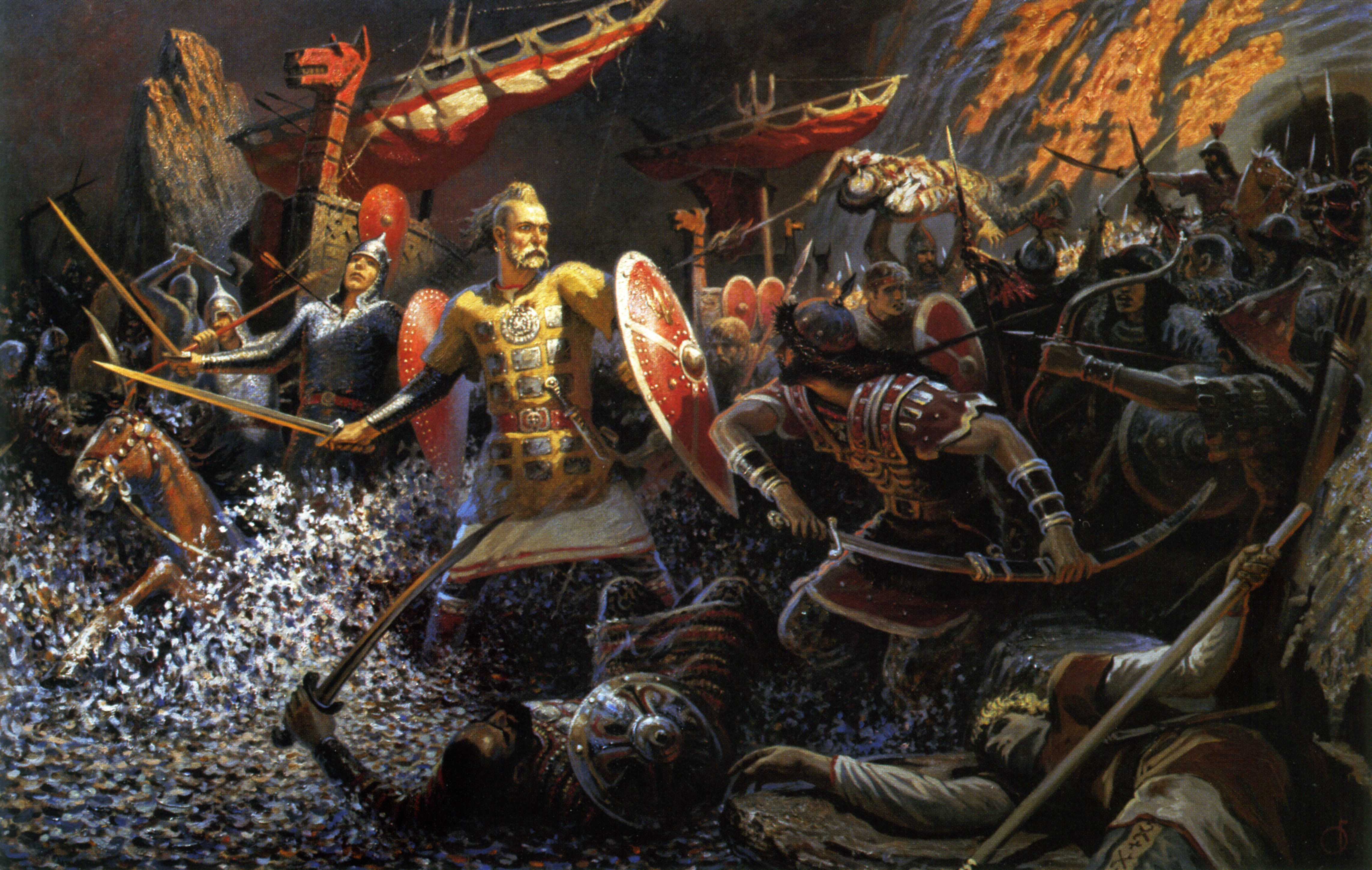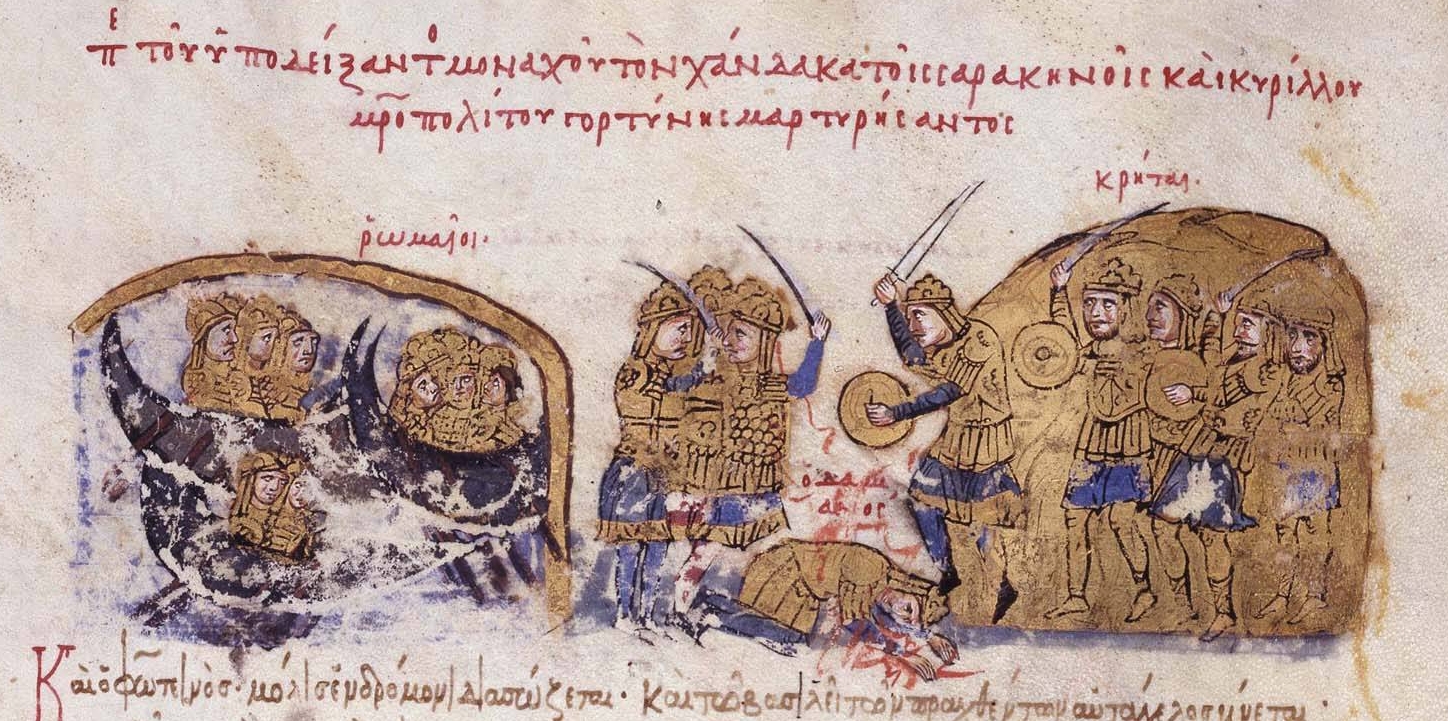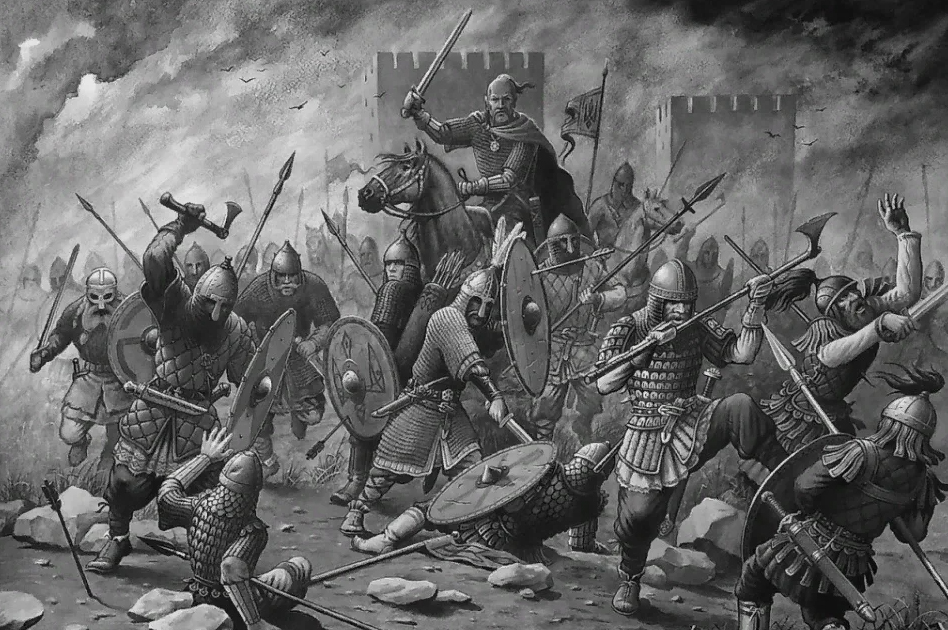A Cretan against Prince Svyatoslav


The Grand Duke of Kiev Svyatoslav Igorevich became famous as a warlord. He was the father of St. Vladimir, the Red Sun by whom was Christianized the Kievan Rus’. The historian Karamzin called Svyatoslav “the Macedonian of Ancient Russia”.
This story, the ending of which is the defeat of the Rus’ people* near the city of Dorostol in Bulgaria and the death of Prince Svyatoslav during the retreat, deserves to be told from its very beginning. Our readers have probably not heard about a son of the last Cretan emir and his dramatic meeting in the battle with Svyatoslav.
The island of Crete has been under Arab rule for more than 135 years; and this period began in 825, when Byzantium, which owned the islands, was greatly weakened after the revolt of Thomas the Slav–the largest civil war in the history of the Byzantine Empire. A part of the rebel Arabs, expelled from Andalusia and unable to gain a foothold in the Baghdad Caliphate, after a series of reconnaissance raids, decided to carry out their military expansion to Crete. Having sailed from Alexandria on 40 ships with their families, they calmly landed in the bay of Souda and robbed the island for 20 days without meeting any serious resistance. Their leader even ordered their ships to be burned so that they could not sail back. Step by step they began to conquer the island. The place where Heraklion is now, the Arabs turned into the Chandax fortress–the later Candia. Powerful walls were built around the city and surrounded by a deep moat (hence the Arabic name of the city meaning “moat”). On the island, the Cretan Muslim Emirate was created, although most of the local population continued to be Christians.
Byzantium tried to recapture the island. The following year, a military expedition was sent to Crete, led by the strategos of the Anatolian Theme** Photeinos, great-grandfather of Empress Zoe Carbonopsina. Having managed to settle down on the island by this time, the Arabs resisted him so much that he asked for help; and arrived protosparharias Damian, but this didn’t help either: the latter fell, and the strategos barely managed to escape from captivity.
In 827, a new attempt was made to conquer the island. The strategos of the Сibyrrhaeot Theme Crateros with 70 ships defeated the fleet of Crete. The whole operation initially developed successfully, but at a night, probably in the morning, the Arabs attacked the careless after their victory Byzantines and defeated them so that Crateros himself could barely escape to the island of Kos. However, the Arabs caught him there to crucify.
There were other unsuccessful attempts, including an expedition to Crete in 911 with the participation of 700 Rus’ people. However, these attempts did not prevent the Arabs from turning the island into a stronghold and engaging in systematic piracy, and the slave trade. Pirates robbed the islands of the Aegean Sea, Peloponnese and, in particular, plundered Mount Athos, captured the monks. They also reached the coast of Dalmatia. Not all of them got away with it. The Byzantines repeatedly smashed their squadrons but could not put an end to the sea robbery of the Cretan invaders, and Crete remained Arab.
The raids of Cretan Muslims into Byzantine-controlled territories, which, according to the Greeks, turned the sea coast and most of the islands into a desert, forced the Byzantine emperors to return the island to their control. The reckoning has arrived in July 960, exactly 1060 years ago. The future Emperor Nikephoros II approached Crete with a large fleet. The landing took place at the mouth of the Almiros River, near Chandax. A long siege of this powerful fortress began. In early spring, Nikephoros launched an unsuccessful assault, accompanied by heavy losses for the besiegers. Then the Greeks decided to use digging and ram. Ballista began to shell the besieged. Some people went down into the moat to dig the foundation of the walls while another rammed. In the dig under the walls, wooden beams were installed; they dragged brushwood and set it on fire. When the fire broke out, two towers with a wall between them cracked and collapsed. So, after eight-month siege, on March 6, 961, Chandax was stormed.
The city was devoted to robbery and destruction. On 300 ships, the wealth of it was transported to Byzantium. There were ordered not to kill those who disarmed. Christians and those who converted to Christianity were allowed for ransom to stay on the island and continue to do their household work, the rest were enslaved. In addition to the garrison, some of the Armenians serving in the army were left to settle in Crete, to increase the island’s defenders. From them, the ancient village of Armenoi has been preserved to the present day. Its name means “Armenians”. On the side of the Byzantines fought also some Rus’ people.
The emir of Crete Abd al-Aziz and his co-ruler and son al-Nu’man were brought to Constantinople. Among the captives, they participated in the triumphal procession of the winners at the hippodrome of Constantinople. The last emir of Crete refused to be baptized, but he was settled in the Byzantine capital with the right to profess his faith. Emir was described as a small, pale, bald, and very ill, but an eloquent and flattering speaker who died a few years later. Al-Nu’man converted to Christianity and entered into the personal guard of the emperor with the name Anemas.

After this campaign, Nikephoros gained immense popularity allowed him soon to occupy the imperial throne.
After a devastating Magyar raid through Bulgarian territory in 965, Byzantium saw no reason to continue with the annual tribute to a weakened Bulgaria, and Nikephoros refused to do it. The historian Leo Deacon, who lived at that time, reports that Nikephoros, having broken relations with Bulgaria, sent to Kiev patrikios Kalokyros as his envoy with fifteen quintals of gold (about 500 kg) to the prince Svyatoslav with a proposal to attack Bulgaria in order to divert the attention of the Bulgarians from south to north.
It is believed, that the Rus’ dominated in the southern Russian steppes (after the defeat of the Khazars by Svytoslav), threatening the coastal possessions of Byzantium in the Northern Black Sea region; and the emperor decided to divert their aggression in a direction favorable to himself.
As Constantinople wanted, Svyatoslav attacked Bulgaria, but the emperor miscalculated in the intentions of the prince. Having captured the town of Pereyaslavets***, Svyatoslav simply settled in it and wanted to transfer there the capital of the Rus’. Now, a strong military rival Svyatoslav appeared near the borders of Byzantium instead of the semi-dependent Bulgarian neighbors. The Bulgarian king began to beg for Byzantine help. As a result, a Bulgarian-Byzantine alliance was concluded against the Rus’, and two Bulgarian princes remained hostage in Constantinople. Apparently by bribery, in 968 Nikephoros prompted the Pechenegs to make their first raid on Rus’, and Svyatoslav had to return to Kiev.
Great changes, meanwhile, took place in Constantinople. A conspiracy was formed against the harsh and unsociable emperor Nikephoros. It was headed by his wife Theophano and her lover John Tzimiskes, the brilliant associate of Nikephoros. The emperor was brutally murdered, and Tzimiskes took possession of the throne.
Having driven the Pechenegs away and refusing to transfer his conquests to Byzantium, Svyatoslav with 60 thousand troops returned to Bulgaria to continue its conquest. Ignoring the persuasion of Tzimiskes to leave Bulgaria, so that Byzantium would get it, he faced there with its Byzantine allies. This prompted him to move his troops to Constantinople. Tzimiskes in response, having removed land and naval forces from the east, landed on the Danube near the city of Dorostolon and strengthened his position in Northern Bulgaria, threatening to “lock up” Svyatoslav, cutting of the path to Kiev. So, it came to the battle of Dorostolon, described by Leo Deacon. Here is his story on the penultimate battle of July 20, 971 near the city of Dorostolon, occupied by the Rus’.
“When the Rus’ left the city, the Romans (Byzantine Greeks) opposed them with a thick phalanx. Then Anemas, one of the royal bodyguards and the son of the Cretan emir, saw Ikmore–the first man under Svyatoslav and the first leader of the Russian army, a man of gigantic stature and extraordinary courage, who attacked with fury and a detachment of selected soldiers, defeating many Romans,–put spurs to his horse and set off on Ikmore. Approaching, he hit him in the cervical ligaments. The severed head of that one, together with his right hand, fell to the ground. At the sight of this, a scream mixed with sobs rose in the ranks of the Rus’, and the Romans rushed at them. Unable to withstand the onslaught of the enemy, they, greatly depressed by the death of their leader, covering their backs with their shields, began to retreat to the city.”
Modern scholars believe that the Byzantine historian Deacon meant with Ikmore perhaps Igor, the cousin of Svyatoslav, mentioned in one document of that time. His Norman name then pronounced “Ingvar”.
In the last battle, held near Dorostolon, Anemas set himself the goal of killing Svyatoslav. Having made his way to him, he apparently struck his crowning blow between the back of the head and shoulder, an area protected by an aventail.*** A blow knocked the prince off his horse, but the armor saved Svyatoslav, and some Rus’ came to his aid, attacking Anemas. The latter was able to kill several of them, but in the end was killed himself.
It is curious that Leo Deacon obviously describes here a saber strike. Just in the 10th century, saber weapons began to spread among the Arabs. An ancient saber can be seen in the Topkapı Palace in the collection of “the Prophet’s swords”, probably dating back to the 7th or 8th century. Among other things, the collection was of great ceremonial significance for the Ottomans. The Sultan was considered as ascended the throne after he went through the “girdle ceremony”, when he chose one of the Prophet’s swords and wore. It was held between the second and seventh day of his ascension to the throne. If the issue of succession to the throne was not settled, the occupation of the throne took place in a hurry, then they tried to implement it as quickly as possible, as almost the first official act after which the ascendant to the throne was already officially considered the Sultan. It was held until the very end of the Ottoman Empire.

On his return from Dorostolon, Svyatoslav was killed by the Pechenegs in 972 on the Dnieper rapids. Many historians suggest that it was a result of the Byzantine diplomacy, which again convinced the Pechenegs to attack Svyatoslav, but the real result of his Balkan campaign was the collapse of the Old Bulgarian Kingdom.
Since that time, the surname “Anemas”, the descendants of the emir’s son, appeared among the Byzantine nobility. Even an Anema prison for nobility appeared in Constantinople located in a tower, allegedly built by Alexios I Komnenos in the 12th century in the Blahernae wall of the capital and so named because one representative from the said family was there the first noble prisoner: a military aristocrat Mikhail Anemas, head of the conspiracy against Alexios Komnenos. The remains of this prison–basement cells–are still preserved. The prominent architect Sinan of Greek-Armenian origin, considered to be the father of Ottoman architecture, used the foundation of this tower during the construction of one of his masterpieces in the second half of the 16th century, the Kazasker Ivaz Efendi Mosque. Cells and tunnels in the underground part of the prison under the mosque’s terrace were repeatedly used in the shooting of Turkish historical films, including the comedy “Perfidious Byzantium”.
* Rus’–a generic name for all people of Slavic origin who lived at different times in the territories from the Ural Mountains in the east to the Atlantic Ocean in the west, from the Arctic Ocean in the north to the Black Sea, the Caucasus Range and the Caspian Sea in the south. However, the Romans distinguished their Slavic neighbors: the Sklavines from the Danube region, the Ants from the territory of modern Ukraine, as well as the Bulgarians.
** Thema–a military-administrative district of the Byzantine Empire where the entirely of the military power belonged to the strategos of it.
*** Pereyaslavets was a trade city located near mouths of the Danube. The city’s name is derived from that of the Bulgarian capital of the time, Preslav, and means Little Preslav. Several theories exist regarding the exact location of the city. Excavations have identified a late 10th century Byzantine fortress at the village of Nufăru, Romania (known as Prislav until 1968), located on the Sfântu Gheorghe branch of the Danube, which may indicate it was the location of the Presthlavitza mentioned in Byzantine sources.
****Aventail–a flexible curtain of mail attached to the skull of a helmet that extends to cover the throat, neck and shoulders.
Oleg Loginov, June 2020